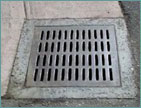
An Australian company, CDS Technologies, has come up with a simple and cost-effective drain that was developed in Sydney while the city was preparing to host the 2000 Olympic games. Its circular design sends the stormwater spinning downward in a vortex. The trash, debris and pollutants are filtered out by a fine screen and trapped in a separation chamber, while the water is able to pass through the screen and continue through the stormwater system. Meanwhile, the trash and pollutants end their down- ward spiral in a sump at the bottom of the drain.
Maintenance crews open the drains and skim off the trash using nets with long poles similar to those used to clean swimming pools. Any trapped water is pumped out and sent to a sanitary sewer, and the sediments are removed, tested for hazardous materials, and sent to a landfill.
Because these drains have no moving parts and use no electricity, they are easy and inexpensive to maintain. So far, CDS Technologies has opened nine offices in the United States and some of its largest drains have been installed in Santa Monica, Calif., a city by the sea. At least seven other countries in Europe and Asia are installing the Australian drains. Sometimes simple solutions are the best ones, and last the longest.


